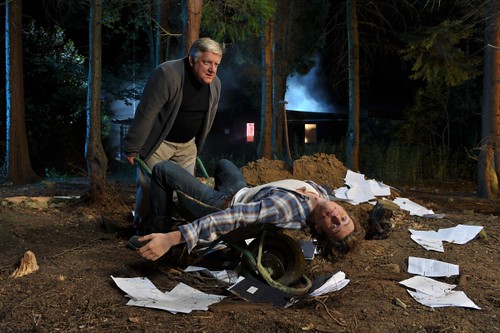If you visit London’s West End these days, you will notice one thing: That Jonathan Groff’s face is everywhere. If you can tear your eyes away from the ubiquitous Deathtrap posters long enough, though, you may remember that it’s a play and not a spread in the September issue of Men’s Vogue.
It’s easy to see why the show’s marketing team went for The Groff Shot over and over again. He’s so camera-ready that having him around almost requires the taking of an oversaturated, moodily-lit photo or two. And his corrupted-choirboy good looks do actually have a point in the show—as they do in anything starring Jonathan.
A perfect face doesn’t guarantee a perfect performance, though, even when looks are so much a part of an actor’s whole equation. In this engaging revival of Ira Levin’s 1978 play, Jonathan gets to play—don’t be shocked—a guy who seems really sweet but is actually really evil. Of course, this could describe any character in Deathtrap, a black comedy about two playwrights who plot to kill each other over one great idea.
But as much as Simon Russel Beale owns the stage as the elder, more experienced playwright—he gets all the good lines and delivers them with throwaway panache—Groff’s role is the more intriguing of the two. Beale starts off shifty and stays that way. (There is something ominously and distinctly off about the elaborate collection of weapons adorning his Connecticut home, after all. In this case, there isn’t just one gun on the mantle. There are four, plus several knives, a crossbow, and axes of all sizes.) But Groff’s character–a promising young writer looking for a mentor–devolves more slowly into complete depravity. He looks gorgeous, but the same really can’t be said for his uneven performance here. In the show’s early scenes, he seems forced. Of course, the character’s attempts at being a nice, honest guy are in themselves an act, but mostly it just sounds like Groff is speeding through the script on too much espresso. It’s only later in the show, when the character’s true (and truly conniving) colors emerge, that he seems more convincing and more at ease. He sure is good looking, though. And he physically dominates the stage to the extent that all of his costars seem to scramble around him, as though they were racing to get out of his shadow.
The play itself is pulpy and fun; its swift, endlessly looping plot (there are no fewer than five attempted, successful, and half-successful murders over the course of the show) never gets old or loses its punch. At the performance I attended, the audience literally gasped in horror at every turn. It makes for an entertaining night at the theater, for sure. The show makes insinuations about deeper meaning—is Deathtrap about competition between artistic rivals, or about the true roots of greed and evil, or about the finer points of playwriting itself? But by the end, all of that is obliterated by the outlandish plot.
American audiences will undoubtedly get to see this version of Deathtrap in the near future. With its shiny leading man and a winning story, it seems instantly transfer-ready. Besides, the show might not be perfect, but it sure is easy on the eyes.
Photo: Hugo Glendinning



{ 1 comment… add one }
Interesting take on Deathtrap — while I’m a bit surprised to hear a negative word said about JG I don’t disagree with your assessment, having seen the show myself. However, any issues I had at the beginning were more than forgiven after the joyous surprise in the middle of the show. Overall I wasn’t bored for a minute (OK, except maybe every time the wife opened her mouth) and I left the theater thoroughly entertained. Further, I completely agree that NYC audiences will do the same! My only criticism is that it will always be a crime to witness a song-less performance by The Groff.